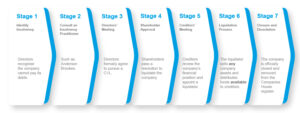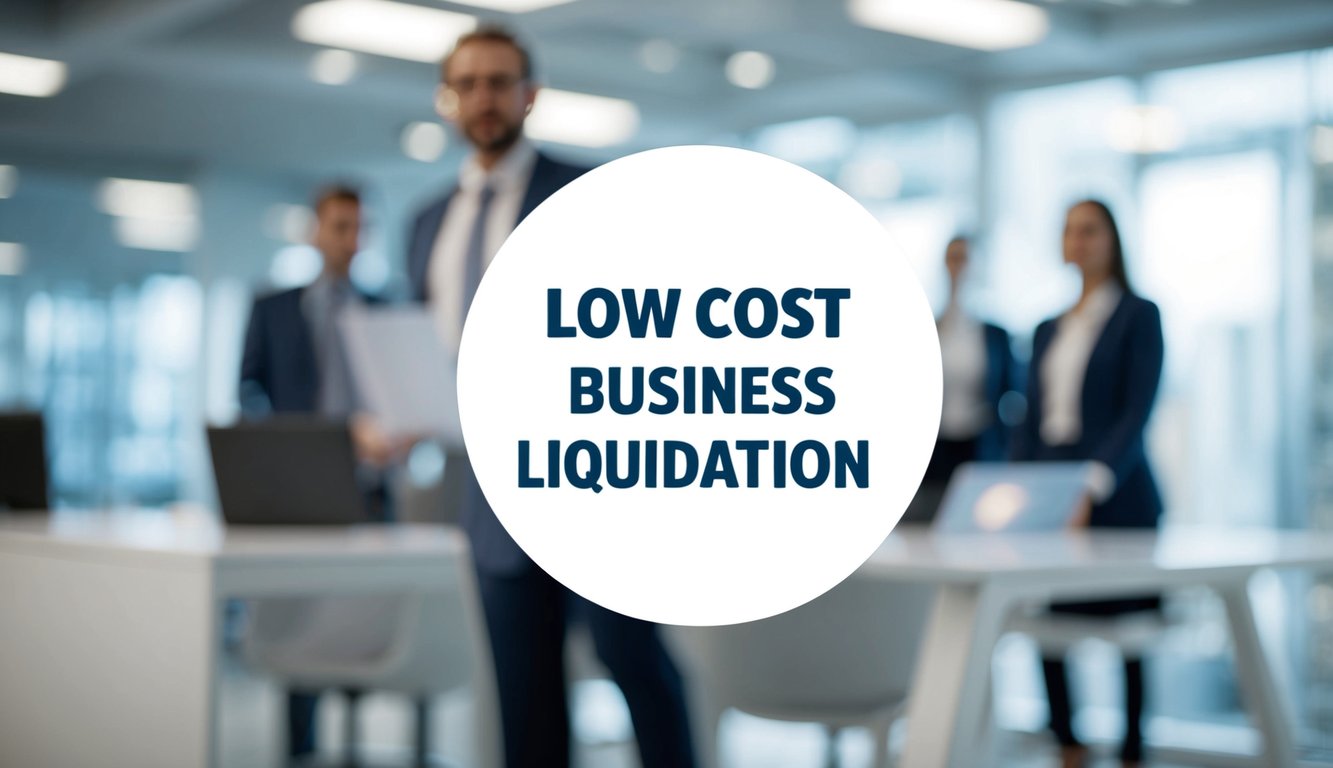Low-Cost Business Liquidation: A Step-by-Step Guide to Closing Shop Efficiently
Understanding Business Liquidation
Business liquidation involves legal processes to close a company, such as distributing assets, and settling debts. The process is complex and needs to be right – it must be handled by licensed insolvency practitioners, such Anderson Brookes. We specialise in working with small and medium sized businesses from across England and Wales who often have business debt, such as HMRC debt. We can place a business into liquidation within 8 days.
As we specialise in business liquidations and do not have our own wider accountancy business for example – we been able to focus on efficient and compliant systems, which provide both a great service and offer real value for money. We encourage you to look at our google reviews which often highlight the benefits of our liquidation service, as well as the low costs involved.
Free Consultation – advice@andersonbrookes.co.uk or call on 0800 1804 935 our freephone number (including from mobiles).
Definition and Types of Liquidation
Liquidation means converting company assets into cash to settle debts and close operations permanently. Two main types exist: voluntary and compulsory liquidation.
Voluntary Liquidation occurs when directors choose to close the company. This includes:
- Members’ Voluntary Liquidation (MVL) for solvent companies
- Creditors’ Voluntary Liquidation (CVL) for insolvent companies
Compulsory Liquidation happens when creditors force a company into closure through court action.
Legal Framework for Liquidation
Licensed insolvency practitioners must oversee all liquidation processes under UK law. They follow strict regulations set by the Insolvency Act 1986.
Your responsibilities as a director include:
- Full disclosure of company assets and liabilities
- Cooperation with the appointed liquidator
- Protection of company assets until liquidation completion
Directors face personal liability if they trade whilst knowingly insolvent or breach their duties.
Signs That a Business Needs Liquidation
Financial Warning Signs:
- Inability to pay bills when due
- Creditor pressure and legal threats
- Mounting tax arrears
- Declining sales and profit margins
Operational Indicators:
- Loss of key customers or contracts
- Unable to secure new finance
- Staff redundancies
- Bounced payments or declined credit
If you spot these signs, seek professional advice immediately. Early action often provides more options and better outcomes.
Low Cost Business Liquidation Google Review

Preparing for Low-Cost Liquidation
Proper preparation and documentation are essential steps before initiating a company liquidation process. Taking time to organise financial records and assess options will help minimise costs whilst ensuring compliance.
Evaluating Company Assets
Begin with a thorough inventory of all company assets, including physical equipment, property, stock, and intangible assets like intellectual property rights.
Create a detailed spreadsheet listing each asset’s current market value and any associated liabilities or loans. This will help determine the total realisable value.
Document proof of ownership for all major assets through receipts, contracts, and registration papers. Clear documentation speeds up the liquidation process and reduces professional fees.
Determining Outstanding Debts
Create a comprehensive list of all creditors, including:
- Trade suppliers
- HMRC obligations
- Staff wages and redundancy payments
- Bank loans and overdrafts
- Equipment finance agreements
Request up-to-date statements from all creditors to confirm exact amounts owed. Organise these by secured and unsecured debts.
Check for any personal guarantees you’ve signed that could affect your liability after liquidation.
Choosing the Right Liquidation Method
Members’ Voluntary Liquidation (MVL) is ideal for solvent companies with assets over £25,000. This method offers tax advantages through Capital Gains Tax relief.
Creditors’ Voluntary Liquidation (CVL) suits insolvent companies. Fees typically start from £3,000 to £5,000, depending on complexity.
Consider company dissolution under Section 1003 if your business has minimal assets and straightforward debts. This represents the lowest-cost option at around £8 for the striking-off fee.
Take professional advice to ensure the chosen method meets legal requirements and provides the best financial outcome.
Implementing the Liquidation Process
A successful business liquidation requires careful organisation and strict adherence to legal protocols. Professional guidance from a licensed insolvency practitioner ensures compliance with all statutory requirements.
Notifying Creditors and Shareholders
Begin by drafting formal notices to all creditors and shareholders. These must be sent via registered post at least 14 days before any liquidation proceedings commence.
Create a comprehensive list of all creditors, including contact details and the amounts owed. This list will form part of your Statement of Affairs document.
Schedule a creditors’ meeting where you’ll present the liquidation plan and address any concerns. Keep detailed minutes of this meeting for legal records.
Required Documents for Notification:
- Statement of Affairs
- Declaration of Solvency (if applicable)
- Notice of General Meeting
- Creditors’ Proof of Debt forms
Asset Sales and Distribution
Conduct a thorough inventory of all company assets, including physical equipment, stock, and intellectual property. Professional valuations help establish fair market prices.
List assets on appropriate platforms based on their type:
- Industrial equipment through specialist auctioneers
- Office furniture via local resellers
- Stock through bulk buyers or discounted retail sales
Create a distribution hierarchy that follows legal requirements:
- Secured creditors
- Employee claims
- Unsecured creditors
- Shareholders
Finalising Legal Obligations
Submit all required documentation to Companies House within 14 days of the resolution to liquidate. This includes form DS01 if pursuing dissolution.
Maintain detailed records of all transactions and communications throughout the process. Store these records for a minimum of six years.
Contact HMRC to settle any outstanding tax obligations and request final clearance. Submit your final VAT return and cancel your VAT registration.
Ensure all employee-related matters are properly concluded:
- Issue P45s
- Process redundancy payments
- Transfer pension arrangements
Liquidation Process – 7 Key Stages

Anderson Brookes can place a business into liquidation within 8 days! Contact us today.
Free Consultation – advice@andersonbrookes.co.uk or call on 0800 1804 935 our freephone number (including from mobiles).
Cost-Reduction Strategies
Implementing targeted financial measures can significantly reduce the costs associated with business liquidation whilst maintaining essential operations and legal compliance.
Negotiating with Creditors
Start by creating a comprehensive list of all creditors and their outstanding amounts. Contact each creditor individually to discuss payment arrangements.
Propose realistic payment plans that reflect your current financial situation. Many creditors prefer receiving partial payments over getting nothing through formal liquidation.
Request interest freezes and payment holidays where possible. Document all agreements in writing to prevent future misunderstandings.
Minimising Professional Fees
Compare fees from multiple insolvency practitioners and solicitors. Request detailed breakdowns of their charges and services.
Consider handling administrative tasks internally to reduce billable hours. Tasks like gathering documents and communicating with stakeholders can often be managed by your team.
Look for practitioners who offer fixed-fee arrangements rather than hourly rates. This provides cost certainty and helps with budgeting.
Opting for Voluntary Liquidation
Voluntary liquidation typically costs less than forced liquidation through court proceedings. Acting early gives you more control over the process.
Choose the most appropriate form of voluntary liquidation based on your company’s circumstances. Members’ Voluntary Liquidation (MVL) suits solvent companies, whilst Creditors’ Voluntary Liquidation (CVL) is for insolvent ones.
Time your liquidation strategically to minimise tax implications and maximise asset values. Consider selling assets privately before beginning the formal process.
Dealing with Employees and Pensions
During liquidation, your employees’ rights and pensions require careful consideration. You must follow specific legal requirements to handle these matters correctly.
Your staff become automatically redundant when your company enters liquidation. The appointed insolvency practitioner takes responsibility for managing employee-related matters.
Key employee entitlements include:
- Unpaid wages
- Holiday pay
- Statutory redundancy payments
- Notice pay
- Pension contributions
If your company lacks funds to pay these entitlements, employees can claim from the National Insurance Fund. The government’s Redundancy Payments Service manages these claims.
For workplace pensions, the Pension Protection Fund offers protection. It covers 100% of pension payments for retired employees and up to 90% for those yet to retire.
You must provide your employees with RP1 forms to claim their entitlements. The insolvency practitioner will guide your staff through this process.
Important: Make sure to communicate clearly with your employees about the situation. Provide them with all necessary documentation and contact details for the insolvency practitioner.
Consider setting up a meeting between your employees and the insolvency practitioner to address questions and concerns directly.
You may also like:
Record-Keeping and Compliance
Proper record-keeping is crucial when liquidating your company to meet legal requirements and protect yourself from future complications. UK law mandates specific retention periods and documentation standards that you must follow.
Maintaining Accurate Records
You must retain all company records for a minimum of six years after liquidation according to the Companies Act 2006. This includes financial statements, tax documents, and business transactions.
VAT-registered companies need to keep VAT records for six years, extending to 10 years if using the VAT Mini One Stop Shop (MOSS) scheme for digital services. You may also be interested in VAT debt.
Essential records to maintain:
- Annual accounts and financial statements
- Bank statements and transactions
- Employee records and payroll information
- Tax returns and VAT documentation
- Business contracts and correspondence
Meeting Compliance Requirements
Failing to maintain proper records after liquidation can result in fines and legal actions against directors. The responsibility falls on you to ensure all documentation is properly preserved and accessible.
Store your records in a secure, organised system that allows easy retrieval if needed by HMRC or other authorities. Digital storage is acceptable, provided you maintain backup copies and ensure data integrity.
Create a checklist of required documents and review it regularly to confirm compliance. Mark each document with its required retention date to prevent premature disposal.
Consider appointing a designated person or professional service to manage your records during the retention period. This helps ensure nothing falls through the cracks.
Free Consultation – advice@andersonbrookes.co.uk or call on 0800 1804 935 our freephone number (including from mobiles).
Selling Assets and Inventory Management
Efficient asset sales and inventory liquidation strategies can help maximise returns during business closure. Proper timing and preparation create opportunities to recover significant value from business assets.
Strategies for Asset Sales
Start by creating a detailed inventory list of all business assets, including equipment, furniture, and vehicles. Value each item at current market rates to set realistic pricing.
Consider multiple sales channels to reach different buyer groups. Online marketplaces like eBay and specialised equipment auction sites can attract targeted buyers.
Bundle similar items together to make them more attractive to bulk purchasers. This approach works particularly well for office furniture and smaller equipment.
Set clear payment terms and ensure all sales are properly documented. Accept secure payment methods like bank transfers or escrow services for high-value items.
Inventory Liquidation Procedures
Calculate your minimum acceptable price for each product category. Factor in storage costs and depreciation when setting discounts.
Create a tiered discount structure, starting with smaller markdowns and increasing them gradually. This approach helps maintain profit margins while clearing stock efficiently.
Contact wholesale buyers and liquidation specialists who might purchase entire product lines. These buyers often offer quick sales, though at lower prices.
Use targeted marketing to reach potential buyers. Email existing customers about clearance sales and leverage social media to spread the word.
Monitor stock levels closely and adjust prices based on sales velocity. Items that aren’t selling may need deeper discounts or alternative sales channels.
Post-Liquidation Considerations
The period after liquidating your business requires careful attention to legal obligations and administrative tasks to ensure a proper closure of your company’s affairs.
Dealing with Remaining Debts
You must address any outstanding debts promptly after liquidation. The appointed liquidator will handle the distribution of available funds to creditors according to their priority ranking.
Keep detailed records of all debt settlements and communications with creditors. These documents may be necessary for future reference or legal requirements.
If personal guarantees were attached to any business loans, you remain responsible for these even after the company’s liquidation. Contact affected creditors to arrange payment plans if needed.
Closure and Deregistration of Company
You need to notify Companies House within 14 days of the final meeting. The liquidator will submit form LIQ13 to initiate the dissolution process.
Preserve all company records for at least six years from the date of dissolution. These include:
- Financial statements
- Tax documents
- Employee records
- Meeting minutes
- Asset disposal records
Your company will be officially dissolved three months after the notice appears in The Gazette. During this period, interested parties can object to the dissolution if they have valid grounds.
Monitor your credit report regularly, as the liquidation will appear on it for six years. This may affect your future business ventures or credit applications.
Frequently Asked Questions
Business liquidation involves multiple legal processes, financial considerations and director obligations that must be carefully navigated. Companies have several options available depending on their specific circumstances and financial position.
How can a company be liquidated when it has outstanding debts?
A licensed insolvency practitioner must be appointed to manage the liquidation process when debts exist. They will gather and sell company assets to pay creditors according to legal priority.
The official liquidator handles negotiations with creditors and ensures compliance with insolvency regulations. You may need to contribute personal funds if company assets cannot cover the liquidation costs.
What are the responsibilities of a company director during the liquidation process?
You must provide complete financial records and documentation about company affairs to the liquidator. This includes accounts, contracts, employee details and asset registers.
Directors are required to cooperate fully with investigations into the company’s trading history. You must also cease trading immediately unless specifically authorised by the liquidator.
What are the different forms of company liquidation available?
Creditors’ Voluntary Liquidation (CVL) allows insolvent companies to voluntarily initiate liquidation with creditor approval. This costs from £1,800 plus VAT through licensed practitioners.
Compulsory liquidation occurs through court order and often has lower upfront costs. Members’ Voluntary Liquidation is for solvent companies wanting to close and distribute assets to shareholders.
Is it possible for a business to undergo liquidation without any cost?
Free liquidation is not possible as professional fees and legal costs must be paid. The minimum costs include insolvency practitioner fees, court fees and document filing charges.
Company assets typically fund these expenses. Directors may need to personally contribute if insufficient assets exist.
What steps should be taken for a swift business liquidation?
Gather all company financial records and documentation before meeting with an insolvency practitioner. Inform employees, customers and suppliers promptly about the liquidation plans.
Cease trading activities immediately unless continuing trade benefits creditors. Cooperate fully with the appointed liquidator to expedite asset sales and creditor payments.
Can liquidating a business be a profitable decision?
Solvent companies can return value to shareholders through Members’ Voluntary Liquidation. This allows for tax-efficient distribution of retained profits and assets.
Insolvent liquidation focuses on maximising creditor returns rather than generating profit. The process aims to achieve the best possible outcome from a difficult financial situation.



